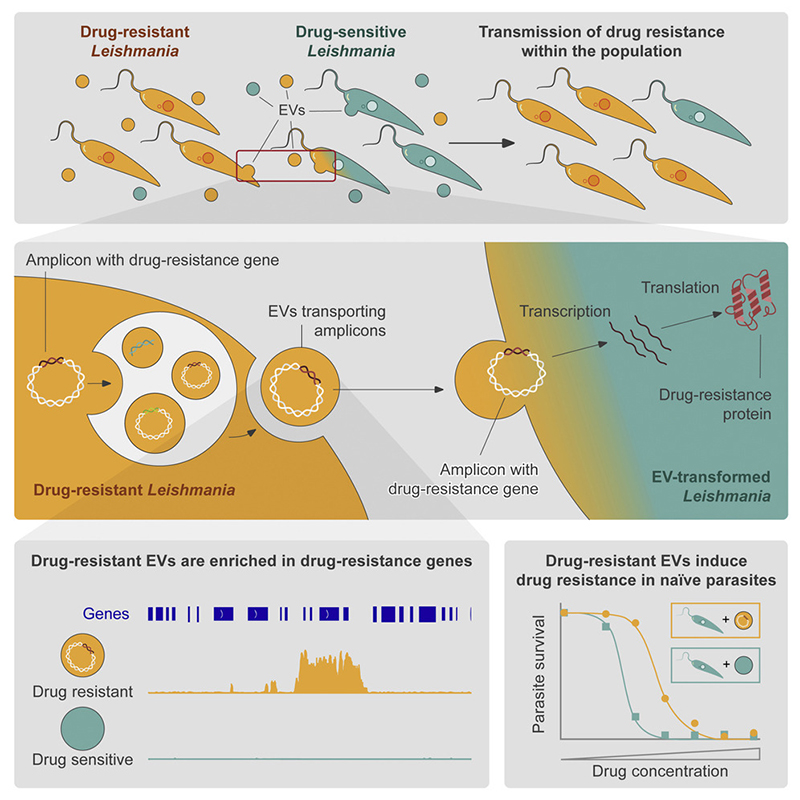Breakthrough discovery on drug resistance named one of Quebec Science’s top Discoveries of the Year
A team of Montreal researchers discovers a new mechanism of transmission of drug resistance in eukaryotic cells.
Researchers at the Université de Montréal, the Research Institute of the McGill University Health Centre (RI-MUHC) and McGill University have uncovered a mechanism for the transmission of drug resistance between Leishmania parasites, which are responsible for a devastating infection known as leishmaniasis. Named one of Quebec Science's Top Ten Discoveries of 2022, the discovery of this mechanism used in intercellular (cell-to-cell) communication could lead to important advances in combating resistance to drugs that are used in treating not only this tropical infection, but also cancer and other infectious diseases.

"It has long been known that drug resistance can occur when a pathogen (an organism or agent that causes disease) comes into contact with a medication. This is precisely why we must monitor and restrict the use of antibiotics," explains Martin Olivier, PhD, co-principal investigator of the study and scientist in the Infectious Diseases and Immunity in Global Health Program at the RI-MUHC. "What has been newly discovered is that drug resistance can also spread from one cell to another without the presence of the medication.”
The Leishmania parasite, which is transmitted through the bite of an infected female sandfly, causes significant symptoms in over 1.5 million people each year, including skin lesions that lead to severe scarring and disability. Prevalent in tropical and subtropical regions, the infection has been spreading northward. Its expansion may be facilitated by climate change, as new habitats become suitable for vector insects and for species that carry the disease.
In their study published in July 2022 in the journal Cell Reports, the researchers demonstrated that drug-resistant Leishmania release extracellular vesicles (cell-secreted nanoparticles) that contain drug resistance genes. These resistance genes are transmitted to drug-sensitive (non-resistant) parasites via the vesicles. As the parasites receive these vesicles, they in turn become drug-resistant and more vigorous, which promotes the proliferation of the infection.

“The fight against Leishmania parasites has been neglected and they have grown resistant to the few existing treatments, leading to serious consequences for both human and canine patients," explains Christopher Fernandez Prada, co-lead investigator of the study and associate professor at the Faculty of Veterinary Medicine of the Université de Montréal. “Because of this predicament, several countries have stopped using the medications in question. Still, resistance to treatment has continued to spread in unexplained ways. As a result of our work highlighting the role of extracellular vesicles in the transmission of drug resistance, the mystery has now been solved, and the search for effective drugs to stop the spread of resistance can thankfully begin.”
This breakthrough paves the way to developing drugs that can inhibit vesicle formation not only in Leishmania parasites, but in eukaryotic cells in general, that is to say, in cells that form the living world. Such medications could potentially be designed to overcome drug resistance in the treatment of many diseases.
“This is the first demonstration of DNA transfer via extracellular vesicles in eukaryotic cells, which make up the animal and plant world”, adds Martin Olivier. As such it constitutes a major breakthrough, and opens up new avenues to tackle treatment resistance."
To learn more, read the Québec Science magazine article
And don't forget to vote!

About the study
The study Leishmania parasites exchange drug-resistance genes through extracellular vesicles was conducted by Noélie Douanne, George Dong, Atia Amin, Lorena Bernardo, Mathieu Blanchette, David Langlais, Martin Olivier and Christopher Fernandez-Prada.

